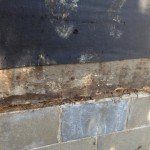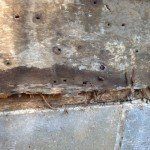Time Capsule
We continue to move forward with the work on the exterior of the MMA Science Library – soon to become the EcologyLab/Classroom and a state-of-the-art natural science collections storage facility – and planning for the interior. The roofer was back to complete some minor work on the original roof tiles from the 1930s and the carpenter is now getting ready to work on the gutters and downspouts. The engineer was here to assess the drainage around the building – we seem to collect a lot of water as we are at the bottom of the slight incline on Vestal Street. The plan is to find better ways to get water away from the building.
The carpenter also worked on re-shingling a small area on the south side of the building where water had been leaking from a gutter – now repaired – and that was also heavily shaded by some hedge that has now been removed to allow that area to breathe. Happily, the only rotted part was the shingles which were doing their job. Once the shingles were stripped away, the original circa 1830 sheathing boards were revealed as you see here. A time capsule in a way because these boards are part of the original William Mitchell schoolhouse. In 1919, the MMA was given the building by a Mitchell family member. The building was picked up, rotated, and put on a new foundation to serve as the MMA Science Library. Some minor alterations were made as the building had sat vacant for a few years but it was moved intact to where you see it today.
I like to think that William Mitchell may have run his hands over these sheathing boards as he thought about the new school he was going to open. In Nantucket fashion however, when he taught in this building it was on Howard Street. Once he no longer owned it, it sort of followed him – coming to live on Vestal Street around the late 1830s or so. Later it became the West Introductory School – a public school.
The other interesting point to make is the holes in the sheathing boards. You don’t see many holes do you? That means that the shingles currently on it are likely only the second ones put on! And the only ones to be put on with tar paper! Now that is really exciting.
JNLF
Recent Posts






